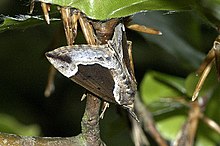Blueberry beaked owl
| Blueberry beaked owl | ||||||||||||
|---|---|---|---|---|---|---|---|---|---|---|---|---|

Blueberry-beaked owl ( Hypena crassalis ) |
||||||||||||
| Systematics | ||||||||||||
|
||||||||||||
| Scientific name | ||||||||||||
| Hypena crassalis | ||||||||||||
| ( Fabricius , 1787) |
The bilberry-beaked owl ( Hypena crassalis , syn .: Bomolocha fontis ), sometimes also called bilberry- beaked owl or velvet owl, is a butterfly ( moth ) from the family of the owl butterflies (Noctuidae).
features
butterfly
The wingspan of the moth is 32 to 37 millimeters. The upper side of the forewings is dark brown to black-brown, the submarginal region whitish, sometimes also darkened gray-brown. An ocher-colored, sometimes light pink line extends from the root over the inner edge and including the outer transverse line. The blemishes are reduced to indistinct black spots. A large, dark shadow can be seen below the very pointed apex . The hind wings are gray-brown without drawing. The proboscis of the moths is well developed. The long palps are stretched out like a beak.
Caterpillar
Adult caterpillars are greenish in color. They are slim, 14-footed and show clearly separated segments. The segment incisions are yellow. The green head, brown on the sides, is dotted with black. Individual hairs protrude from the black point warts.
distribution and habitat
The blueberry beaked owl is widespread in Central Europe. To the east the distribution area extends to Armenia . In the Alps it rises to altitudes of 1,800 meters. The animals are preferably found in coniferous and mixed forests as well as in raised and heather bogs.
Way of life
The crepuscular and nocturnal moths fly in one generation between May and September and are sometimes scared away from the vegetation during the day. They visit bait and artificial light sources at night . The leaves of the bilberry ( Vaccinium myrtillus ) are the main food of the caterpillars . Occasionally they have also been observed on bog berries ( Vaccinium uliginosum ) or heather ( Erica ). The species overwinters either as an adult caterpillar or as a pupa.
swell
Individual evidence
- ↑ a b Michael Fibiger, László Ronkay, José Luis Yela, Alberto Zilli: Noctuidae Europaeae. Volume 12, Entomological Press, Sorø, Denmark 2010, ISBN 978-87-89430-17-1 , p. 125.
- ^ A b Walter Forster, Theodor A. Wohlfahrt: The butterflies of Central Europe. Volume 4: Owls. (Noctuidae). Franckh'sche Verlagshandlung, Stuttgart 1971, ISBN 3-440-03752-5 , p. 308.
- ^ Günter Ebert (Ed.): The butterflies of Baden-Württemberg. Volume 5: Moths III (Sesiidae, Arctiidae, Noctuidae). Ulmer Verlag, Stuttgart 1997, ISBN 3-8001-3481-0 , pp. 431-433.
- ↑ Arno Bergmann: The large butterflies of Central Germany. Volume 4/2: Owls. Distribution, forms and communities. Urania-Verlag, Jena 1954, DNB 450378381 , pp. 991-993.
literature
- Günter Ebert (Ed.): The butterflies of Baden-Württemberg. Volume 5: Moths III (Sesiidae, Arctiidae, Noctuidae). Ulmer Verlag, Stuttgart 1997, ISBN 3-8001-3481-0 , pp. 431-433.
- Michael Fibiger, László Ronkay, José Luis Yela, Alberto Zilli: Noctuidae Europaeae. Volume 12, Entomological Press, Sorø, Denmark 2010, ISBN 978-87-89430-17-1 , p. 125.
- Walter Forster , Theodor A. Wohlfahrt : The butterflies of Central Europe. Volume 4: Owls. (Noctuidae). Franckh'sche Verlagshandlung, Stuttgart 1971, ISBN 3-440-03752-5 , p. 308.
- Manfred Koch : We determine butterflies. Volume 3: Owls. 2nd, expanded edition. Neumann, Leipzig / Radebeul 1972, DNB 760072930 , pp. 258-259.
Web links
- Lepiforum eV - taxonomy and photos
- pyrgus.de - Butterflies and their ecology
- www.nic.funet.fi - dissemination
- www.schmetterlinge-deutschlands.de - endangerment
- Hypena crassalis in Fauna Europaea. Retrieved November 11, 2016
